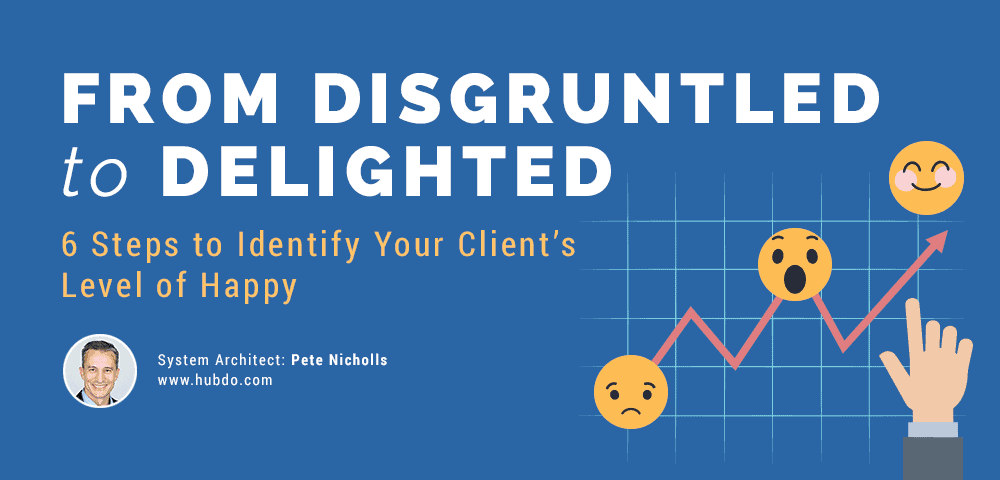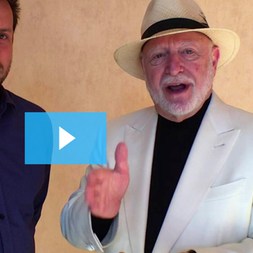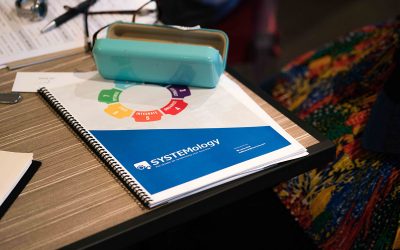
System Architect | Pete Nicholls: hubdo.com
In business, the happiness of your clients is vital, because let’s face it, without happy clients you wouldn’t have a business at all.
This brings us to the question of: “How do you know if your clients are happy?”
Unless they’ve recently told you so, then you probably don’t. So, how do you find out if your clients are happy? How do you identify the delighted from the disgruntled? By using a system to find out.
Pete Nicholls from Hubdo explains the Net Promoter System® (NPS) which has been used and loved by Disney, Lego, and Qantas to name a few.
NPS is used to identify both your delighted clients, allowing you to get more business and referrals, and your disgruntled clients, giving you the information you need to improve their experience.
Let’s get started.
How to Identify Your Clients’ Level of Happy
Step 1: Send your clients a one question survey following the – Net Promoter System® (NPS).
- Delighted.com is recommended because it is optimized for NPS (alternatives include: SurveyMonkey and Salesforce).
- Use one-question survey to your customers. Use a scale and ask them to rate the purchase they made from you.
- On a scale of 0 to 10 how likely are you to recommend (or refer) us to a friend?
- Make sure to use numbers 0-10 (and not 0-5) to better segment the audience. ‘Friend’ is a positive keyword and motivator.
- After your customer rates you, ask them to comment their rating.
- For example, tell us a bit more about why you chose 9.
Step 2: Identify who are you going to survey
- Identify those customers who have had a recent experience – within the last 6 months. Keep it small – between 200 and 250 for the first survey.
- Export the data to a spreadsheet – to use later for segmentation.
Step 3: Send out the survey to your selected group
- Suggestion! Send between 6am and 9am, Mondays or Tuesdays to get a good return.
Step 4: Calculate your Net Promoter System® (NPS) score
- Setup and format a spreadsheet with the data from your survey.
- Name, Email, Segment
- Segmentation examples: Male or Female, location (state, town).
- Classify all those who respond into one of 3 groups:
- Promoter: score of 9 or 10.
- These are people who love your products and services and who will be your advocates.
- Passive: score of 7 or 8.
- These people are on the fence so think of ways to motivate them. The greatest ROI (Return On Investment) is to move people from Passive to Promoter.
- Detractor: score of 6 or below.
- Decide whether this is someone who is genuinely upset, or just not a good fit for your business. Are they your target market? If so, you may have something to fix.
- Count the responses – add up the number of responses provided for each score.
- Group the responses – add up the total number of responses provided for each group.
- Calculate your NPS – subtract the percentage of Detractors from the percentage of Promoters. The result is your NPS number (it is not a percentage).
- Track your NPS over time – your numerical NPS allows you to quantify how changes you make to your product affect the customer experience over time.
Step 5: Respond to your survey respondents
- Respond to Promoters:
- Send a quick personal “Thank you”.
- Ask for permission to share.
- Share this with your staff for motivation.
- Brainstorm a VIP program based on the feedback.
- Respond to Passives:
- Send a quick personal “Thank you”.
- Look for opportunities to turn passives into promoters.
- Respond to Detractors:
- Reply within 2 hours (24 hours max).
- Send a quick personal “Thank you”.
- Deal with any urgent matters that they’ve raised.
- Identify keepers vs. bad fit, move on.
Note! If an NPS tool like delighted.com is being used, it automates steps 1-5 and handles segmentation analysis without the need for spreadsheets.
Step 6: Bridge the gap
- Inner loop – meet internally to discuss the results.
- Look at what’s broken: was it people, process or product?
- Corrective action requests to track through things that you fix.
- Take ongoing NPS scores to check that you are improving your results.
- Add feedback to your customers database (CRM) and build your customer relationships.
Who is delighted? Who is disgruntled? Take the time to see what you can do.
If you don’t know how delighted or disgruntled your clients are, then you have no way of gaining more referrals or improving your client’s experience. So, it really is vital you take the time to find out with a system like this one on how to know if the customer is satisfied.
By connecting with your clients, identifying them, responding and taking the appropriate action, you will be well on your way to a business filled with delighted clients – and who wouldn’t want that?
Want to find out a little more before you get started? You can hear more from Pete Nicholls himself right here, in the video below.
System Architect –Pete Nicholls
Pete Nicholls is the Director and Marketing Technologist at HubDo.com, the global Marketing Stacks Company. Following 16 years with Cisco as Technical Director, Sales and Business Development, Pete heads hubdo.com, a Global Provider of Marketing Stacks for Consultants and Agencies.
HubDo delivers integrated Done For You solutions as Marketing Stacks for Consultants and Agencies, built on Best In Class software including HubSpot, integrated and automated using HubDo Glue, for lead generation, customer acquisition, and client engagement.















